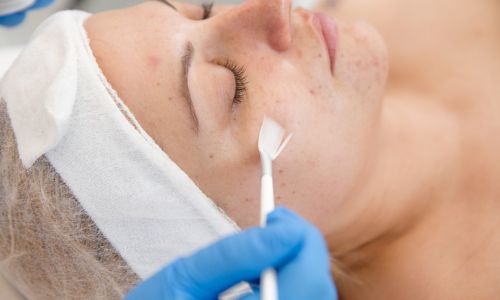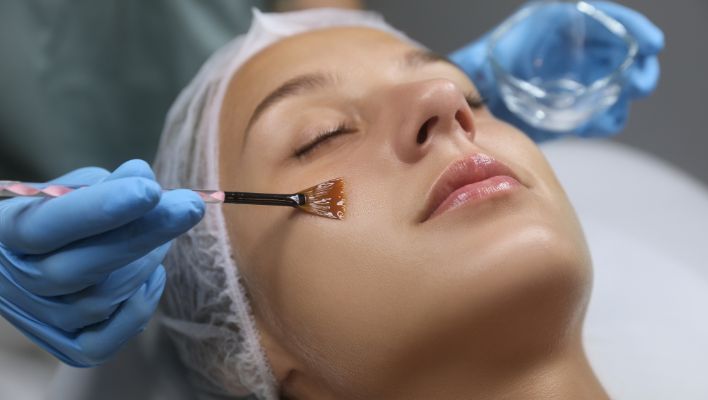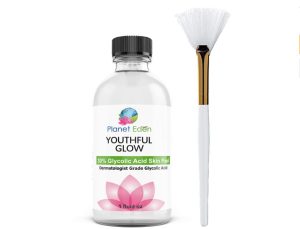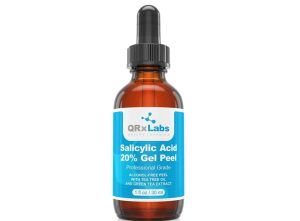Sun damage is a common skin concern among us who love spending time outdoors. While sun protection is a must, sometimes we forget to apply sunscreen or spend more time in the sun than we should. This can result in sun damage, which can manifest as dark spots, fine lines, wrinkles, and uneven skin tone. To get rid of this sun damage, fortunately, chemical peels can play the vital role to reverse the effects of sun damage and restore your skin’s natural radiance. In this article, we are going to share the best chemical peel for sun damage.

Why choose chemical peels for sun-damaged skin?
Chemical peels are a safe, effective treatment that can improve sun-damaged skin. They involve the application of a chemical solution to the face, neck, or hands.
The peeling process removes the outer layer of dead skin cells. Eventually, the new skin will reveal a smoother complexion and fewer wrinkles.
4 Best Chemical Peels To Reverse Sun Damage
A quick at the top Chemical Peels To Reverse Sun Damage:
1.Glycolic Acid For Diminishing Sun Damage, Dark Spots, Fine Lines, Wrinkles
2. Salicylic Acid for Acne Treatment
3. Trichloroacetic Acid: Guaranteed Authentic Original Formula
4. Phenol for Face Breakout Scars
1. Glycolic Acid
Glycolic acid is the best exfoliant and can help minimize the appearance of fine lines and wrinkles. It also accelerates skin cell renewal and increases collagen production to keep your skin looking youthful.
Dermatologists Recommended Glycolic Acid
Planet Eden Glycolic AHA Acid Skin Chemical Peel
This acid can also reduce hyperpigmentation (skin tone irregularities, sun spots, melasma). It is safe to use and will not harm your skin’s lipids (the healthy fatty acids that make up the bouncy barrier of your skin), so it is safe for all skin types and shades.
But be sure to use it slowly – higher concentrations of glycolic acid can cause more severe irritation when your skin is not accustomed to it.
If you decide to try a chemical peel for sun damage, schedule a consultation with a licensed dermatologist or esthetician first. They will be able to guide you on the correct concentrations and pH levels that are best for your skin.
2. Salicylic Acid
Chemical peels are an excellent treatment for reducing the appearance of sun damage and pigment imperfections such as hyperpigmentation. They can also be used to reduce the size of pores and improve the texture of the skin.
Top Pick
Professional Grade Chemical Face Peel for Acne Treatment
Salicylic Acid is a popular superficial peeling agent that works well on oily/acne-prone skin and clogged pores. It is also an effective exfoliating agent that helps clear blemishes and reduce breakouts caused by acne.
It is also an anti-inflammatory that is gentle enough for sensitive skin. Moreover, it is very effective on dehydrated/dry skin, dull and uneven skin tone, and psoriasis.
Typically, at-home peels contain up to 20% salicylic acid and can be applied on the skin’s surface to help improve mild breakouts, soften minor flaws, and brighten dull skin. They are available over the counter at many cosmetic and salon stores.
3. Trichloroacetic Acid
Trichloroacetic Acid is the best chemical peel for sun damage because it effectively removes a damaged layer of skin while leaving a new, fresh, and healthy one behind. It has been used for years as a popular, non-invasive, and effective treatment for many skin conditions, including melasma, hyperpigmentation, and sun damage.
Best chemical peel for sun damage
TCA Original Color And Lightener Accelerator
TCA is available in a variety of strengths, from light to medium, and your dermatologist can determine the best strength for you based on your needs. Lower strengths provide subtle improvements, while stronger concentrations are ideal for treating deep wrinkles, more severe scars, and precancerous skin lesions such as actinic keratosis.
TCA can be used alone or combined with other acids to improve your results. It is a safe and effective skin peeling solution that helps correct sun damaged and aging skin. It is especially helpful for reducing discoloration and improving overall skin tone.
4. Phenol
Deep chemical peels such as phenol can dramatically improve many skin conditions, including sun damage. The treatment removes the outer layers of dead skin to reveal the underlying layers of new skin.
It is also one of the best options for improving uneven skin tone and texture and minimizing fine lines and wrinkles. This is because a deep peel can penetrate deeply into the dermis, which helps stimulate collagen production and reduce fine lines and wrinkles.
Phenol peels are used primarily to treat coarse facial wrinkles, areas of blotchy or damaged skin caused by sun exposure, and certain pre-cancerous growths and deep acne scars. It can also help diminish the appearance of sunspots, freckles, and hyperpigmentation.
Typically, a phenol peel is performed under local anesthesia in the office or an outpatient surgical facility. The procedure takes between one and three hours, depending on the size of the area being treated.
Possible Risks of Chemical Peels for Sun Damage
There are several potential risks associated with this procedure, particularly when treating sun-damaged skin.
Hyperpigmentation: Hyperpigmentation is a common side effect of chemical peels, particularly in individuals with darker skin tones. This occurs when the skin produces too much melanin in response to the peeling process, resulting in dark spots or patches on the skin.
Infection: Chemical peels can create small wounds on the skin, which can increase the risk of infection. It is important to follow proper aftercare instructions and keep the treated area clean to minimize this risk.
Scarring: Although rare, chemical peels can also result in scarring, particularly in individuals with sensitive skin or a history of scarring.
Sun Sensitivity: Chemical peels can make the skin more sensitive to sunlight, which can increase the risk of sunburn and other forms of sun damage. It is important to avoid sun exposure and use a broad-spectrum sunscreen with an SPF of at least 30 after a chemical peel.
How to Minimize the Risks of Chemical Peels for Sun Damage?
- Avoiding sun exposure for at least one week after the procedure.
- Using a broad-spectrum sunscreen with an SPF of at least 30 every day.
- Keeping the treated area clean and moisturized.
- Avoiding picking or peeling at the skin.
- Following any additional instructions provided by your skincare professional.




